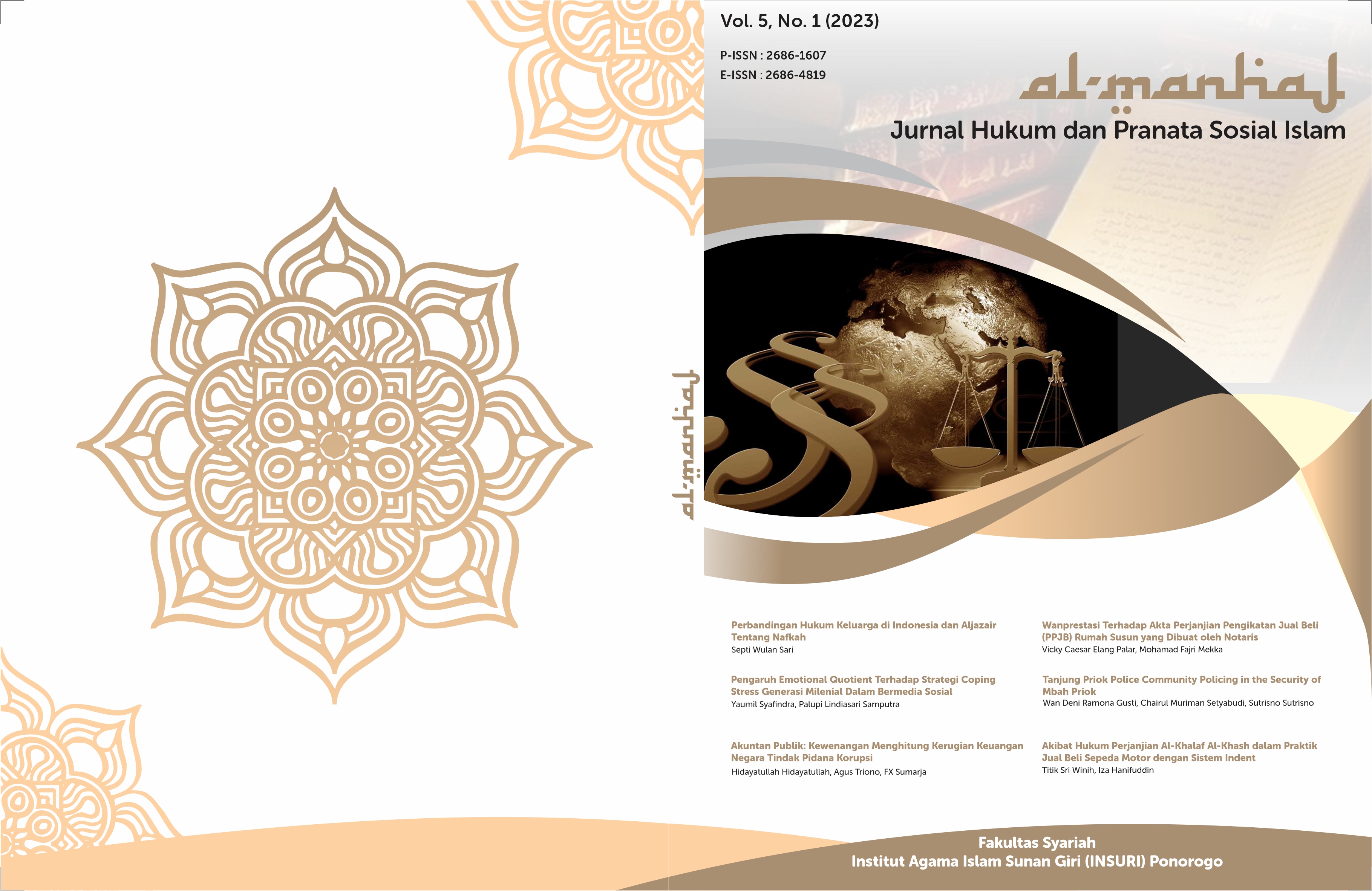PERBEDAAN INTERPRETASI HUKUM MENIKAHI WANITA HAMIL (Analisis Terhadap Pasal 53 Kompilasi Hukum Islam Perspektif Maqhosid Syari’ah)
DOI:
https://doi.org/10.37680/almanhaj.v5i1.1602Keywords:
Marriage; Pregnant Marriage; Law and Maqhosid Syari'ahAbstract
Law is a controller of human behavior, but not the least of the legal rules there are different interpretations. KHI as the law that regulates marriage in Indonesia cannot be separated from this, namely Article 53 concerning Pregnant Marriage. In regulating human life, law must consider the aspects of benefit and harm (maqhosid syrai'ah). The purpose of this paper is to clarify the purpose of KHI Article 53 as law. In this study the method used is a qualitative research method and uses the Maqhosid Syari'ah approach. While the sources of data collection in this study are books, articles, manuscripts or the like related to similar themes. The data analysis methods in this study are collecting data, reducing data, presenting data and drawing conclusions. Based on the analysis conducted by KHI Article 53 which regulates pregnant marriage accommodates the maqhosid syari'ah aspect, namely the benefit of protecting honor and offspring.
References
Anshary. (2015). Hukum Perkawinan di Indonesia (Masalah-masalah Krusial). Yogyakarta: Pustaka Pelajar.
Atabik, M. (2014). Pernikahan Dan Hikmahnya Perspektif Hukum Islam. Yudisia Jurnal Pemikiean Hukum dan Hukum Islam , 284-316.
Aulia, T. R. (2017). Kompilasi Hukum Islam (Hukum Perkawinan, Kewarisan dan Perwakafan). Bandung: Nuansa Aulia.
Az-Zuhaily. (2011). Al-fiqh Al-islam Wa Adillatuh. Jakarta: Gema Insani.
Dhaif, S. (2011). Al-Mu'jam Al-Wasith. Mesir: Maktabah Shurouk ad-dauliyah.
Diana, Z. (2014). Pandangan Imam Syafi'i Hanbali Dalam Kasus Pernikahan Wanita Hamil Karena Zina (Studi Perbandingan Mazhab dan KHI). Ijtihad Jurnal Hukum dan Ekonomi Islam , 227-251.
Faizun, A. (2022). Dispensasi Kawin Hamil Di Luar Nikah Menurut Jumhur Ulama (Studi Penetapan Pengadilan Agama Nomor: 0015/Pdt.P/2016/PAJU). Skripsi , 1-79.
Hasan, M. (2011). Penganter Hukum Keluarga. Bandung: CV. Pustaka Setia.
Humaidillah, M. (2002). Status Hukum Akad Nikah Wanita Hamil dan Anaknya. Jakarta: Gema Insani Press.
Junawaroh. (2021). Wanita Hamil di Luar Nikah Perspektif Hukum Islam (Studi Hukum Menikahi, Mentalaq, dan Masa Iddah) . Syaksia Jurnal Hukum Perdata Islam , 331-356.
Khakim, A. (2019). Menjaga Kehormatan Sebagai Perlindungan Nasab Perspektif Maqhosid Syari'ah. Nizham Jurnal Studi Keislaman , 1-40.
Manzur, I. (2009). Lisanu Al-arab, Edisi ke-6. Kairo: Dar El-Ma'ruf.
Millah, J. (2019). Dualisme Hukum Perkawinan Islam di Indonesia. Jakarta: Amzah.
MUI, K. F. (2012). Kumpulan Fatwa-fatwa MUI provinsi DKI Jakarta 1975-2012. Jakarta: Komisi Fatwa MUI DKI Jakarta.
Moleong, L. J. (2018). Metode Penelitian Kualitatif. Bandung: PT Remaja Rosdakarya
Nabawi, A. S. (2018). Pertimbangan Hukum Kepala Kantor Urusan Agama Kecamatan Parubg Kabupaten Bogor Mengenai Nikah Hamil. Mizan Journal of Islamic Law , 127-143.
Nasrullah. (2021). Tinjauan Hukum Islam Terhadap Pernikahan Wanita Hamil Di Luar Nikah (Studi Kasus Di Kantor Urusan Agama Kecamatan Kota-Kota Kediri). Skripsi , 1-69.
Nasrullah, M. H. (2014). Konsep Maqashid Al-Syariah Dalam Menentukan Hukum Islam: Perspektif Al-Syatibi dan Jasser Auda. Al-Iqtishadiyah , 33-41.
Salim, A. (2011). Menikahi Wanita Hamil Karena Zina Ditinjau dari Hukum Islam. Jurnal Ushuliddin , 131-144.
Salma. (2021). Pendekatan Penelitian: Pengertian, Jenis-Jenis, dan Contoh Lengkapnya. Retrieved Maret 2, 2023, from Deepublish: http://penerbitdeepublish/pendekatan-penelitian.com
Suryantoro, R. (2021). Nikah Dalam Pandangan Hukum Islam. Ahsana Media Jurnal Pemikiran, Pendidikan dan Penelitian Ke-Islaman , 38-45.
Wibisana, W. (2017). Perkawinan Wanita Hamil Diluar Nikah Serta Akibat Hukumnya Perspektif Fikih dan Hukum Positif. Ta'lim Jurnal Pendidikan Agama Islam , 29-35.
Yanggo, H. T. (2010). Fikih Perempuan Kontemporer. Bogor: Ghalia Indonesia.
Downloads
Published
How to Cite
Issue
Section
License
Copyright:
- Author retains the copyright and grants the journal the right of first publication of the work simultaneously licensed under a Creative Commons Attribution 4.0 International License that allows others to share the work with an acknowledgment of the work's authorship and initial publication in this journal.
- Author is able to enter into separate, additional contractual arrangements for the non-exclusive distribution of the journal's published version of the work (e.g., post it to an institutional repository or publish it in a book) with the acknowledgment of its initial publication in this journal.
- Author is permitted and encouraged to post his/her work online (e.g., in institutional repositories or on their website) prior to and during the submission process, as it can lead to productive exchanges, as well as earlier and greater citation of the published work (See The Effect of Open Access).
License:
-
Attribution — You must give appropriate credit, provide a link to the license, and indicate if changes were made. You may do so in any reasonable manner, but not in any way that suggests the licensor endorses you or your use.
-
No additional restrictions — You may not apply legal terms or technological measures that legally restrict others from doing anything the license permits.
You are free to:
- Share — copy and redistribute the material in any medium or format
- Adapt — remix, transform, and build upon the material for any purpose, even commercially.

This work is licensed under a Creative Commons Attribution 4.0 International License.














